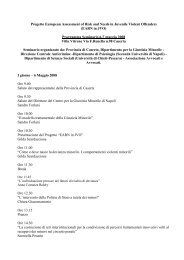Scarica il documento - Dipartimento per la Giustizia Minorile
Scarica il documento - Dipartimento per la Giustizia Minorile
Scarica il documento - Dipartimento per la Giustizia Minorile
Create successful ePaper yourself
Turn your PDF publications into a flip-book with our unique Google optimized e-Paper software.
allegati<br />
of the requirements of the criminal justice system for young offenders. there may be<br />
a need to involve the young <strong>per</strong>son in substance abuse treatment or seek a psychiatric<br />
consultation about a parent, for example.<br />
Wh<strong>il</strong>e the initial Mst involvement may be intensive, <strong>per</strong>haps da<strong>il</strong>y, the ultimate<br />
goal is to empower the fam<strong>il</strong>y to take responsib<strong>il</strong>ity for making and maintaining gains. an<br />
important part of this process is to foster in the parents the ab<strong>il</strong>ity to be good advocates<br />
for their ch<strong>il</strong>dren and themselves with social service agencies and to seek out their own<br />
supports. in other words, parents are encouraged to develop the requisite sk<strong>il</strong>ls to solve<br />
their own problems rather than rely on professionals.<br />
Mst is a flexible intervention ta<strong>il</strong>ored to each unique situation. there is no one<br />
recipe for success. instead, there are nine guiding principles:<br />
1. the primary purpose of assessment is to understand the “fit” between the<br />
identified problems and their broader context<br />
2. therapeutic contacts should emphasise the positive and should use systemic<br />
strengths as levers for change.<br />
3. interventions should be designed to promote responsible behaviour and decrease<br />
irresponsible behaviour among fam<strong>il</strong>y members.<br />
4. interventions should be present-focused and action-oriented, targeting specific<br />
and well-defined problems.<br />
5. interventions should target sequences of behaviour within or between multiple<br />
systems that maintain the identified problems.<br />
6. interventions should be developmentally appropriate and fit the developmental<br />
needs of the young <strong>per</strong>son.<br />
7. interventions should be designed to require da<strong>il</strong>y or weekly effort by fam<strong>il</strong>y<br />
members.<br />
8. intervention efficacy is evaluated continuously from multiple <strong>per</strong>spectives<br />
with providers assuming accountab<strong>il</strong>ity for overcoming barriers to successful<br />
outcomes.<br />
9. interventions should be designed to promote treatment generalisation and longterm<br />
maintenance of therapeutic change by empowering caregivers to address<br />
fam<strong>il</strong>y members’ needs across multiple systemic contexts.<br />
the Mst-specific training augments the education and ex<strong>per</strong>ience therapists bring<br />
from their chosen fields (usually psychology or clinical social work training).<br />
What do MST Therapists do?<br />
Mst therapists do the work in the fam<strong>il</strong>y home rather than in a clinic and are on<br />
call 24 hours a day in working hours. appointments are made to suit the fam<strong>il</strong>y so they<br />
may take p<strong>la</strong>ce in the evening or at weekends. the therapists ta<strong>il</strong>or their working week<br />
and time-off accordingly and in co-ordination with the su<strong>per</strong>visor and the other therapists.<br />
the Mst team w<strong>il</strong>l cover each other so that during time off fam<strong>il</strong>ies can be supported and<br />
be in contact with the team. remuneration takes account of the flexib<strong>il</strong>ity expected of<br />
the therapist. the average caseload is four to six fam<strong>il</strong>ies. especially in the beginning, the<br />
worker may be in the home every day. as needed, they w<strong>il</strong>l spend time at school and meet<br />
with the young <strong>per</strong>son’s peer group and extended fam<strong>il</strong>y. a key part of the process begins<br />
with engaging the fam<strong>il</strong>y, a significant challenge in some cases.<br />
251





